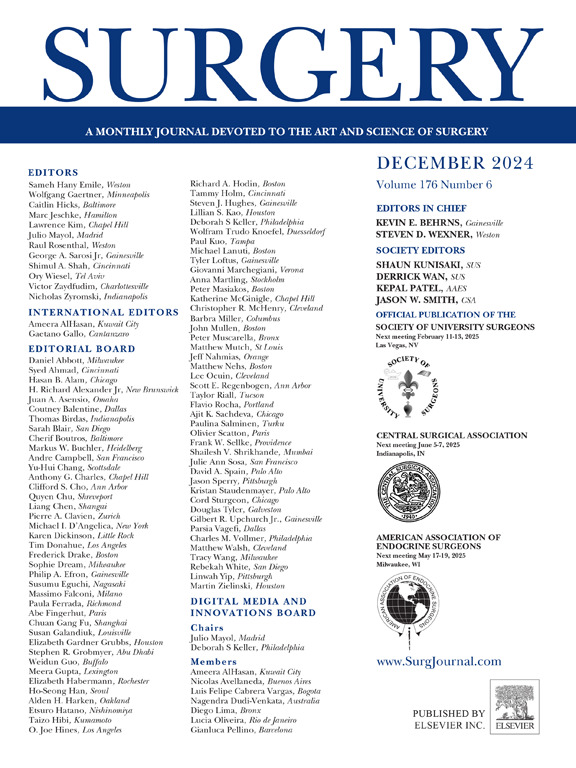乳脂球-表皮生长因子-VIII衍生的寡肽3(MOP3)能减轻肝缺血再灌注损伤的炎症反应并提高存活率。
IF 3.2
2区 医学
Q1 SURGERY
引用次数: 0
摘要
简介肝脏缺血/再灌注损伤是一种严重的临床症状,由于过度炎症,部分由释放的损伤相关分子模式引发,导致高死亡率。细胞外冷诱导 RNA 结合蛋白是一种新的损伤相关分子模式。目前肝缺血再灌注损伤的临床治疗仅限于支持疗法,因此有必要开发新的有效治疗策略。乳脂球-表皮生长因子-VIII衍生寡肽3是一种新发明的寡肽,来源于乳脂球-表皮生长因子-VIII。该肽作为一种 opsonic 化合物,能特异性地与细胞外冷诱导 RNA 结合蛋白结合,促进吞噬细胞对其的清除,从而减轻炎症反应。在这项研究中,我们假设乳脂球-表皮生长因子-VIII衍生的寡肽3通过抑制细胞外冷诱导RNA结合蛋白诱导的Kupffer细胞炎症,减轻了肝缺血再灌注损伤:我们用细胞外冷诱导RNA结合蛋白和不同剂量的乳脂球-表皮生长因子-VIII衍生寡肽3处理雄性C57BL/6小鼠的Kupffer细胞4小时,然后测量培养上清液中的细胞因子。此外,小鼠70%肝脏缺血60分钟后,立即静脉注射载体或乳脂球-表皮生长因子-VIII衍生寡肽3。24 小时后收集血液和缺血肝组织,并测量包括细胞因子、肝酶、趋化因子、髓过氧化物酶活性和 Z-DNA 结合蛋白 1 在内的炎症指标。对肝组织损伤和细胞死亡进行组织学评估。对肝缺血/再灌注后 10 天的存活率进行了监测:结果:牛奶脂肪球-表皮生长因子-VIII衍生寡肽3以剂量依赖性的方式显著减少了细胞外冷诱导RNA结合蛋白挑战的Kupffer细胞释放的白细胞介素-6和肿瘤坏死因子-α。在肝缺血/再灌注小鼠中,乳脂球-表皮生长因子-VIII衍生的寡肽3能显著降低血清中细胞外冷诱导RNA结合蛋白、白细胞介素-6、肿瘤坏死因子-α、天冬氨酸氨基转移酶、丙氨酸氨基转移酶和乳酸脱氢酶的水平。牛奶脂肪球-表皮生长因子-VIII衍生的寡肽3还能显著降低肝组织中白细胞介素-6、肿瘤坏死因子-α、白细胞介素-1β、Z-DNA结合蛋白1和趋化因子巨噬细胞炎症蛋白-2的mRNA水平以及髓过氧化物酶的活性。组织学评估表明,使用乳脂球-表皮生长因子-VIII衍生的寡肽3能显著减轻肝缺血/再灌注小鼠肝脏的组织损伤和细胞死亡。乳脂球-表皮生长因子-VIII衍生的低聚肽3能明显提高肝缺血再灌注小鼠的存活率:结论:乳脂球-表皮生长因子-VIII衍生的低聚肽3能明显减轻肝缺血再灌注后的炎症和肝组织损伤,提高存活率。因此,乳脂球-表皮生长因子-VIII衍生的低聚肽3有望成为未来治疗肝缺血再灌注损伤的一种潜在策略。本文章由计算机程序翻译,如有差异,请以英文原文为准。

Milk fat globule-epidermal growth factor-VIII–derived oligopeptide 3 (MOP3) attenuates inflammation and improves survival in hepatic ischemia/reperfusion injury
Introduction
Hepatic ischemia/reperfusion injury is a severe clinical condition leading to high mortality as the result of excessive inflammation, partially triggered by released damage-associated molecular patterns. Extracellular cold-inducible RNA-binding protein is a new damage-associated molecular pattern. Current clinical management of hepatic ischemia/reperfusion injury is limited to supportive therapy, necessitating the development of novel and effective treatment strategies. Milk fat globule-epidermal growth factor-VIII–derived oligopeptide 3 is a newly invented oligopeptide originating from milk fat globule-epidermal growth factor-VIII. This peptide acts as an opsonic compound that specifically binds to extracellular cold-inducible RNA-binding protein to facilitate its clearance by phagocytes, thereby attenuating inflammation. In this study, we hypothesized that milk fat globule-epidermal growth factor-VIII–derived oligopeptide 3 attenuated hepatic ischemia/reperfusion injury by inhibiting extracellular cold-inducible RNA-binding protein–induced inflammation in Kupffer cells.
Methods
We treated Kupffer cells isolated from male C57BL/6 mice with extracellular cold-inducible RNA-binding protein and various doses of milk fat globule-epidermal growth factor-VIII–derived oligopeptide 3 for 4 hours, then measured cytokines in the culture supernatants. In addition, mice underwent 70% hepatic ischemia for 60 minutes immediately followed by the intravenous administration of either vehicle or milk fat globule-epidermal growth factor-VIII–derived oligopeptide 3. Blood and ischemic liver tissues were collected 24 hours later, and inflammatory markers including cytokines, liver enzymes, chemokines, myeloperoxidase activity, and Z-DNA-binding protein 1 were measured. Hepatic tissue damage and cell death were evaluated histologically. Survival rates were monitored for 10 days posthepatic ischemia/reperfusion.
Results
The release of interleukin-6 and tumor necrosis factor-α from extracellular cold-inducible RNA-binding protein–challenged Kupffer cells was significantly reduced by milk fat globule-epidermal growth factor-VIII–derived oligopeptide 3 in a dose-dependent manner. In hepatic ischemia/reperfusion mice, milk fat globule-epidermal growth factor-VIII–derived oligopeptide 3 treatment significantly decreased serum levels of extracellular cold-inducible RNA-binding protein, interleukin-6, tumor necrosis factor-α, aspartate aminotransferase, alanine aminotransferase, and lactate dehydrogenase. Milk fat globule-epidermal growth factor-VIII–derived oligopeptide 3 treatment also significantly reduced mRNA levels of interleukin-6, tumor necrosis factor-α, interleukin-1β, Z-DNA-binding protein 1, and chemokine macrophage inflammatory protein-2, as well as myeloperoxidase activity in hepatic tissues. Histologic evaluation demonstrated that treatment with milk fat globule-epidermal growth factor-VIII–derived oligopeptide 3 significantly attenuated tissue damage and cell death in the liver of hepatic ischemia/reperfusion mice. Milk fat globule-epidermal growth factor-VIII–derived oligopeptide 3 treatment significantly improved the survival rate of hepatic ischemia/reperfusion mice.
Conclusion
Milk fat globule-epidermal growth factor-VIII–derived oligopeptide 3 significantly attenuated inflammation and liver tissue damage and improved survival after hepatic ischemia/reperfusion. Thus, milk fat globule-epidermal growth factor-VIII–derived oligopeptide 3 holds promise as a potential future therapeutic strategy for hepatic ischemia/reperfusion injury.
求助全文
通过发布文献求助,成功后即可免费获取论文全文。
去求助
来源期刊

Surgery
医学-外科
CiteScore
5.40
自引率
5.30%
发文量
687
审稿时长
64 days
期刊介绍:
For 66 years, Surgery has published practical, authoritative information about procedures, clinical advances, and major trends shaping general surgery. Each issue features original scientific contributions and clinical reports. Peer-reviewed articles cover topics in oncology, trauma, gastrointestinal, vascular, and transplantation surgery. The journal also publishes papers from the meetings of its sponsoring societies, the Society of University Surgeons, the Central Surgical Association, and the American Association of Endocrine Surgeons.
 求助内容:
求助内容: 应助结果提醒方式:
应助结果提醒方式:


